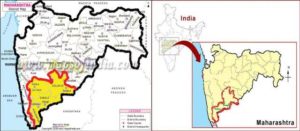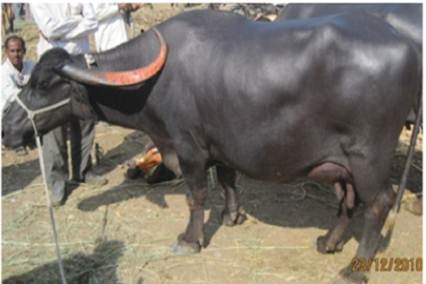PANDHARPURI
- Origin & Breeding Tract
- Physical Characteristics
- Biometry
- Production Traits
- Reproduction Traits
- Housing Management & Practices
The Pandharpuri buffaloes are known to have been reared for more than 150 years in the breeding tract. The local “Gawli” community reared these buffaloes for milk production. These buffaloes had royal patronage from Kolhapur for supply of fresh milk to the wrestlers of Kolhapur. The breed is famous for its better reproductive ability, producing a calf every 12-13 months. Under average management conditions and hot-dry climate,these buffaloes yield 6-7 litters of milk per day. However under good management they are reported to yield up to 15 litters of milk in a day.

The main breeding tract of Pandharpuri buffalo is Solapur, Sangli and Kolhapur districts of Maharastra state which is mostly drought prone. The soil of is black, coarse gray and reddish. In Sangli it is black lateritic, saline, alkaline in low lying patches, while it is black, red-lateritic and black-brown in Kolhapur districts.
The breeding tract of Pandharpuri buffalo comes under scarcity, plain and sub-mountain agro-climatic zones. Average minimum and maximum temperature is between 9°C to 42°C in the breeding tract. The average minimum and maximum humidty is between 43 to 87 percent. The annual rainfall varies between 345.64mm in Sangli to 1168.96mm in Kolhapur district. The rainfall occurs between middle of May to end of October with most rainfall occurring during June to September.The fodder crops commonly grown include Jawar, Maize, Bajra, Oat, Lucerne, Berseem etc.
Some of the important characteristics is described as follows: –
|
Body weight and Growth Rate
The body weight of Pandharpuri buffaloes at different age at ZARS, Kolhapur (females)
| Stage | Center (NARP,Kolhapur) | Center(Gokul) | Center(Warana) | Mean+ S.E |
| At Birth | 27.67 (6) | 28.98 (464) | 26.78 (229) | 27.81+ 0.87 |
| 3 months | 60.25 (12) | 48.90 (363) | 46.32 (194) | 51.96+ 2.47 |
| 6 months | 97.80 (10) | 74.13 (416) | 63.24 (204) | 78.39+ 4.32 |
| 9 months | ||||
| 12 months | 134.00 (5) | 118.15 (369) | 115.30 (227) | 122.48+ 4.87 |
| 18 months | ||||
| 24 months | 195.75 (4) | 189.20 (272) | 178.40 (148) | 187.78+ 5.08 |
| At first calving |
Source: BR Ulmek
Morphological Characteristics
Various values of morphological traits of Pandharpuri buffaloes like body length, height at withers, heart girth and adult weight are given in the following table.
| Characteristic | Calves(upto 6 m) | YoungStock(6 to 24 m) | Young Stock(24 to 48 m) | Bulls | Milch Buffaloes |
| Body Length(cm) | 65.71+0.18 | 5.39+0.47 | 112.17+0.79 | 144.48+0.86 | 133.56+0.94 |
| Height at withers(c) | 64.29+0.21 | 82.95+0.46 | 109.71+0.82 | 141.74+0.86 | 129.81+1.61 |
| Chest Girth(cm) | 79.86+0.35 | 117.35+0.75 | 152.40+0.86 | 205.41+2.31 | 183.52+1.53 |
| Birth Weight(Kg) | |||||
| Adult weight(Kg) |
| Traits | Mean±S.E |
| Average lactation length (days) | 255.60±14.7 |
| Average lactation milk yield (kg) | 1207.70±13.4 |
| Average daily milk yield (kg) | 4.90±0.08 |
| Peak milk yield (kg) | |
| Average Fat% | 7.80±0.07 |
| Average SNF% | 9.40±0.5 |
Ulmek, (2000), Vare, (2001), Mane,(2003) and Khopade, (2009)
Reproduction Traits
- Male
| Traits | Values |
| Age at puberty (months) | |
| Age at first training(months) | 34.28 |
| Age at first ejaculation(months) | 37.63 |
| Age at first mating(months) | 40.81 |
.
- Female
| Traits | Values |
| Age at puberty (months) | 30.59 |
| Age at First Calving (months) | 43.82 |
| Service Period(days) | 97.92 |
| Dry Period(days) | |
| Calving Interval(days) | 407.05 |
| Estrous Cycle Length(days) | 21.82 |
| Estrousn Duration (hrs) | 39.67 |
| Gestation Length (days) | 310.02 |
Housing & Management Practices
Pandharpuri buffaloes are reared mainly for milk. These buffaloes also contribute in manure production and as draft power. The male buffaloes are used for draft and also take part in bull fighting as part of culture and customs in the region. The overall land holding of the buffalo keeper in the breeding tract is medium with average family size of 5.49. The male and female family members are equally involved in day to day management of the animals. Wallowing to Pandharpuri buffaloes is provided in the afternoon time. The main mode of sale purchase of animals is the animal fairs (64.20%). Majority of families (94%) maintain good hygiene during milking operation. The Pandharpuri buffaloes are mostly breed through natural service(50%) followed by A.I. (29.7%) or both (20.3%).
Housing
In the breeding tract of Pandharpuri buffaloes 57.90% farmers provides separate sheds whereas 42.10% farmers provides part of their residence for housing their buffaloes. The buffalo sheds are either open (54.40%) or closed (45.60%). Majority of buffalo owners provide “Kachha” house and flooring in the breeding tract while only 30% farmers provide permanent”pucca” housing to buffaloes. Most of the sheds are well ventilated. Even though only 20.60% buffalo owner provide Pucca type drain, majority of buffalo sheds have good sanitary conditions. In general, adequate housing facility is in practice by farmers for Pandharpuri buffaloes in its breeding tract.
Feeding Practices
The common concentrate fed to different categories of Pandharpuri buffaloes are ground nut cake, cotton seed cake and compounded (pellet) feed. The major sources of green fodder are sugarcane tops and leaves, maize, jawar, and the dry fodders are jawar kadabi, wheat straw and paddy straw.
The calves below 6 months of age are not sent for grazing and are offered concentrate in the morning and evening. Milk is also fed to calves (below 6 months of age) in addition to little amount of green and dry fodder. Green and dry fodders are offered in morning, noon and evening. Milch buffaloes are offered concentrate at milking(55.25%) and other time(44.75%) in morning and evening apart from grazing. Additional concentrate feeding is practiced for breeding bulls.
Milking Practices
The usual milking time varied between 5 a.m to 6.30 a.m in the morning and 4 p.m to 5.30 p.m in the afternoon. In most of the cases women used to milk the Pandharpuri buffaloes and concentrates offered during the milking time.
Knuckling method was used for milking of Pandharpuri buffaloes. After retaining little quantity of milk for home use, rest is sold in city/town. In Kolhapur district road side milking (‘Katta’system) is prevalent. In this system the Pandharpuri buffaloes are milked at a common place and the fresh milk is supplied to the customer. In some cases the Pandharpuri buffaloes are taken door to door for milking and delivering fresh milk to the customers.

